
The Clear Cut Guide To ADUs And Tiny Homes
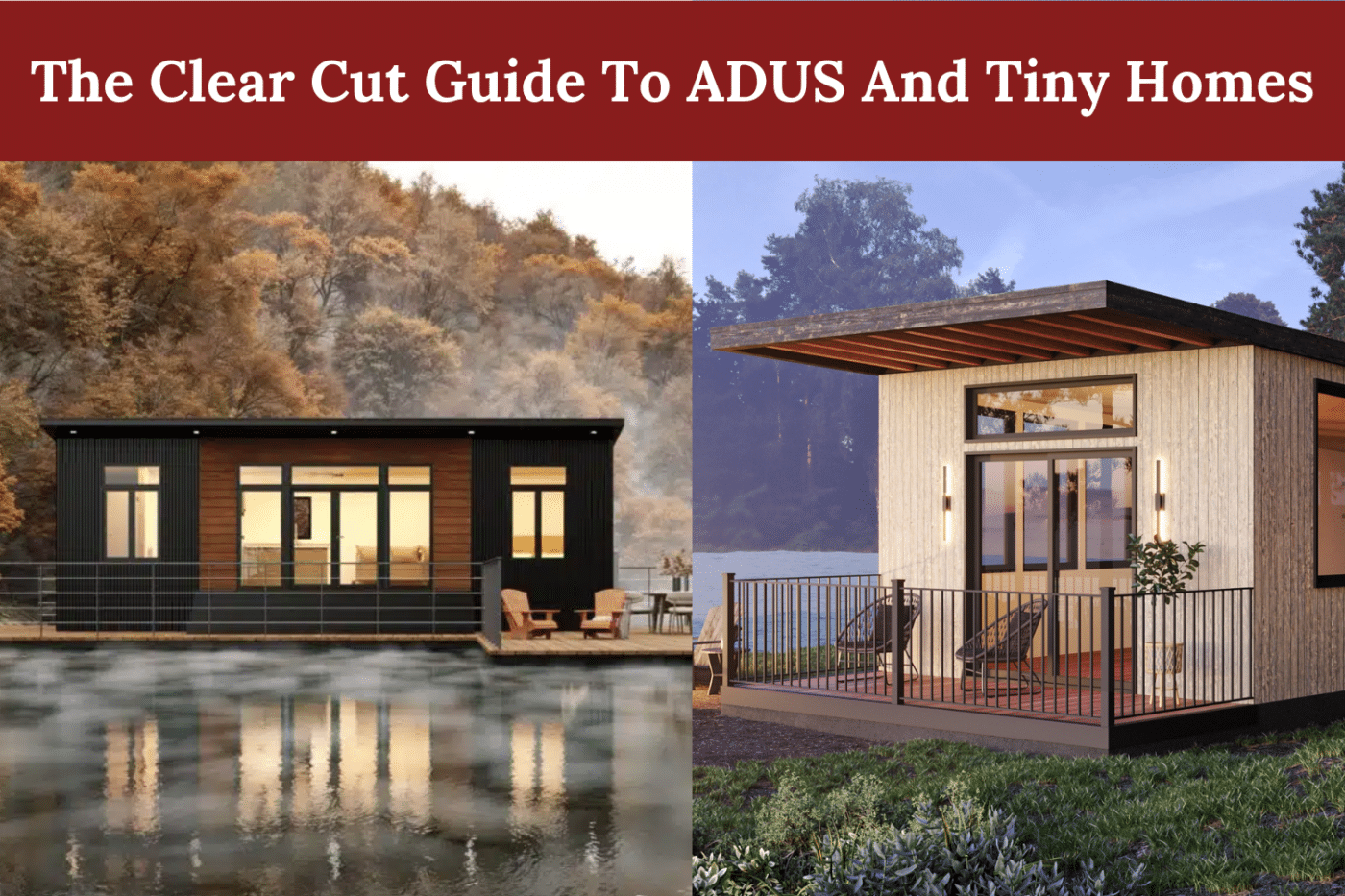
ADUs vs Tiny homes, is there even a difference? As housing prices in the USA continue to stay at record highs, ADUS and Tiny Homes have become even more popular housing options. Yet, it is still unclear what exactly Tiny Homes and ADUs are. In this blog, we cut to the chase and clear up the confusion on these topics, so let’s get into it.
Are ADUs and Tiny Homes The Same Thing?
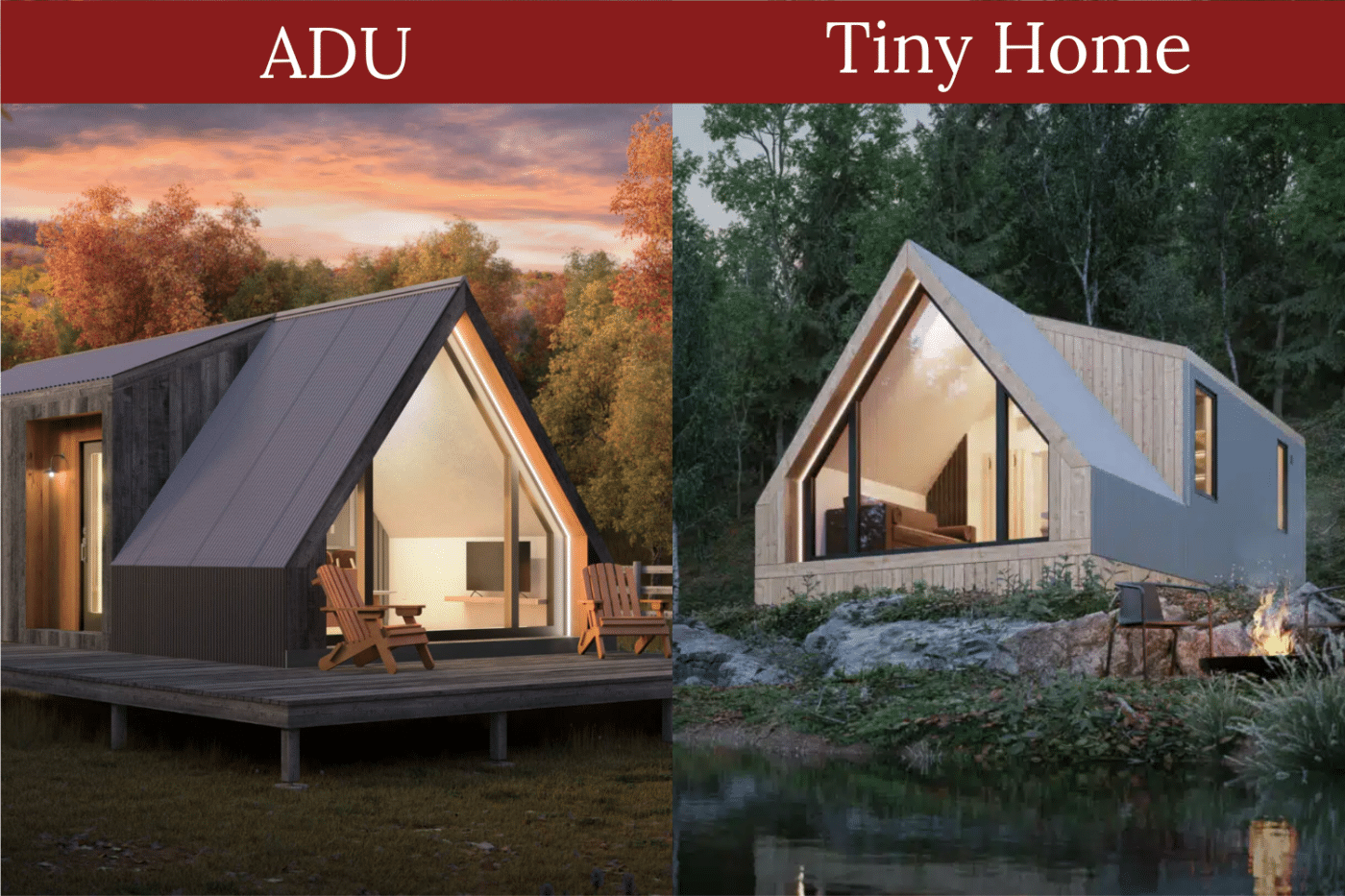
Sometimes. ADUs (Accessory Dwelling Units) simply mean that there is an additional living area that offers a separate entrance and living space from the primary dwelling. This means that if your municipality allows tiny homes, or park models as we call them, to be parked permanently on your property then they could be qualified as an ADU.
However, in many cases, ADU refers to a permanently built structure that is either attached or detached from your main home. These spaces are typically a finished basement, finished attic, or, repurposed garage. In some cases, people will go as far as building a completely new addition to their home to make for an ADU. This is growing in popularity but is still quite a new concept.
All in all, ADUs can be a Tiny Home. However, you will need to see what your local government will allow. In many cases, an ADU is a legal zoning classification of a building, not a specific building style.
Additionally, at Zook Cabins we have made several models of our buildings available in ADU size as well as a Park Model (Tiny Home) size. We choose to do this, so that no matter what home buying needs are, we have just what you are looking for.
Do ADUS or Tiny Homes Have Larger Square Footage?

ADUs often have a larger square footage than a Tiny House. This is because ADUs fall under the stipulations of traditional construction. For example, in the state of Washington, the ADU requirement states that an ADU must be a minimum of 300 square feet and that certain rooms have required measurements.
Generally speaking, a Park Model Tiny Home will have maximum square footage of 400 square feet, but can be as low as 200 square feet. Depending on what size space you need, a tiny home may have all the square footage that you may need. However, if you know from the start that you would like to have more space, we recommend taking a look at our ADUs, as they start with 491 square feet as the minimum.
Are Tiny Homes And ADUs Built The Same Way?
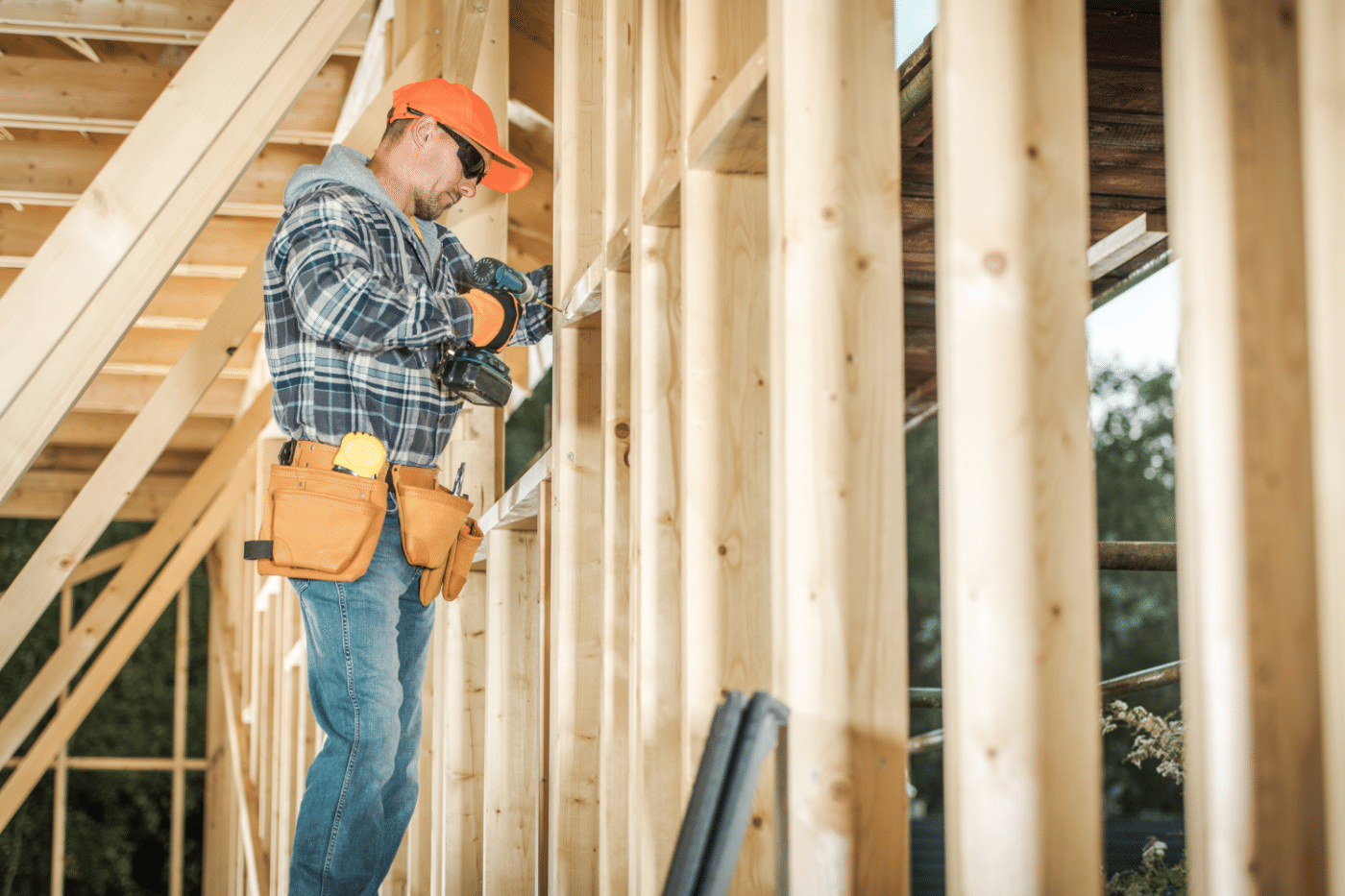
Kind of, there are areas of overlap but they are not built the same way. For example, both structures will be built using typical building materials such as wood, nails, fasteners, and the like. However, Tiny Homes will be built in a way that makes the most of any usable space, as well as emphasizing the use of other lightweight materials. Whereas ADUs are built to the same regulations as typical stick-built homes, in fact, all of our ADUs are built to that of a certified modular home.
Are There Multiple Kinds Of ADUs?
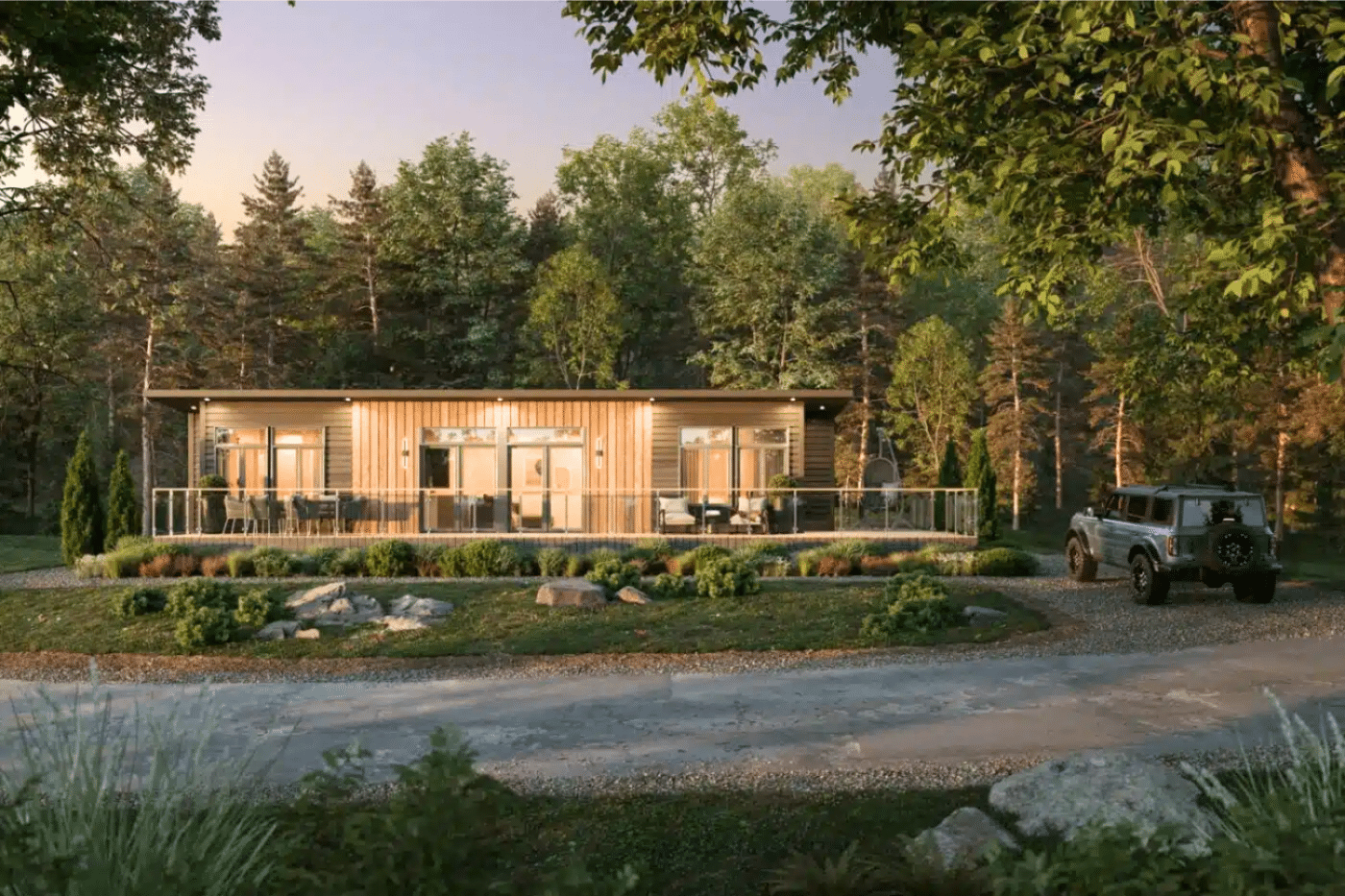
Yes. There are multiple types of ADUs. However, this is usually in relationship to where the ADU is located on the prosperity, as ADU is simply an abbreviation for Accessory Dwelling Unit. Let us explain a bit more what we mean by that.
Attached ADU
An attached ADU means that the ADU is in some way connected to the primary dwelling. This could be a basement, attic, or a completely new addition to the home. However, to truly be an ADU it must have a separate bathroom, kitchen, bedroom space, and entry.
Detached ADU
A detached ADU is an ADU that is built completely separated from the primary dwelling. This would include buildings like our A-Frame ADU, Rockwood ADU, and Sonoma ADU. Everything you could want in a home is available in these styles. These buildings are built to modular home standards and need to be set on a basement or crawl space foundation.
Depending on your municipal needs or your personal wants another great options for a detached accessory dwelling unit is our Sonoma HUD Certified Luxury Mobile Home.
Conversion ADU
Conversion ADUS is when an existing structure is converted into an ADU. This is very typical of a detached garage or garden house on the property. Many times these are seen as detached ADUs. Some states offer grants to change or update an existing structure into an ADU.
If you want to learn some more specifics about ADUs head on over to our blog titled “What Are ADUs?”. Also, check out our blog to see if your state is ADU-friendly “Top 7 ADU-Friendly States”.
What Are The Major Differences Between ADUs and Tiny Homes?
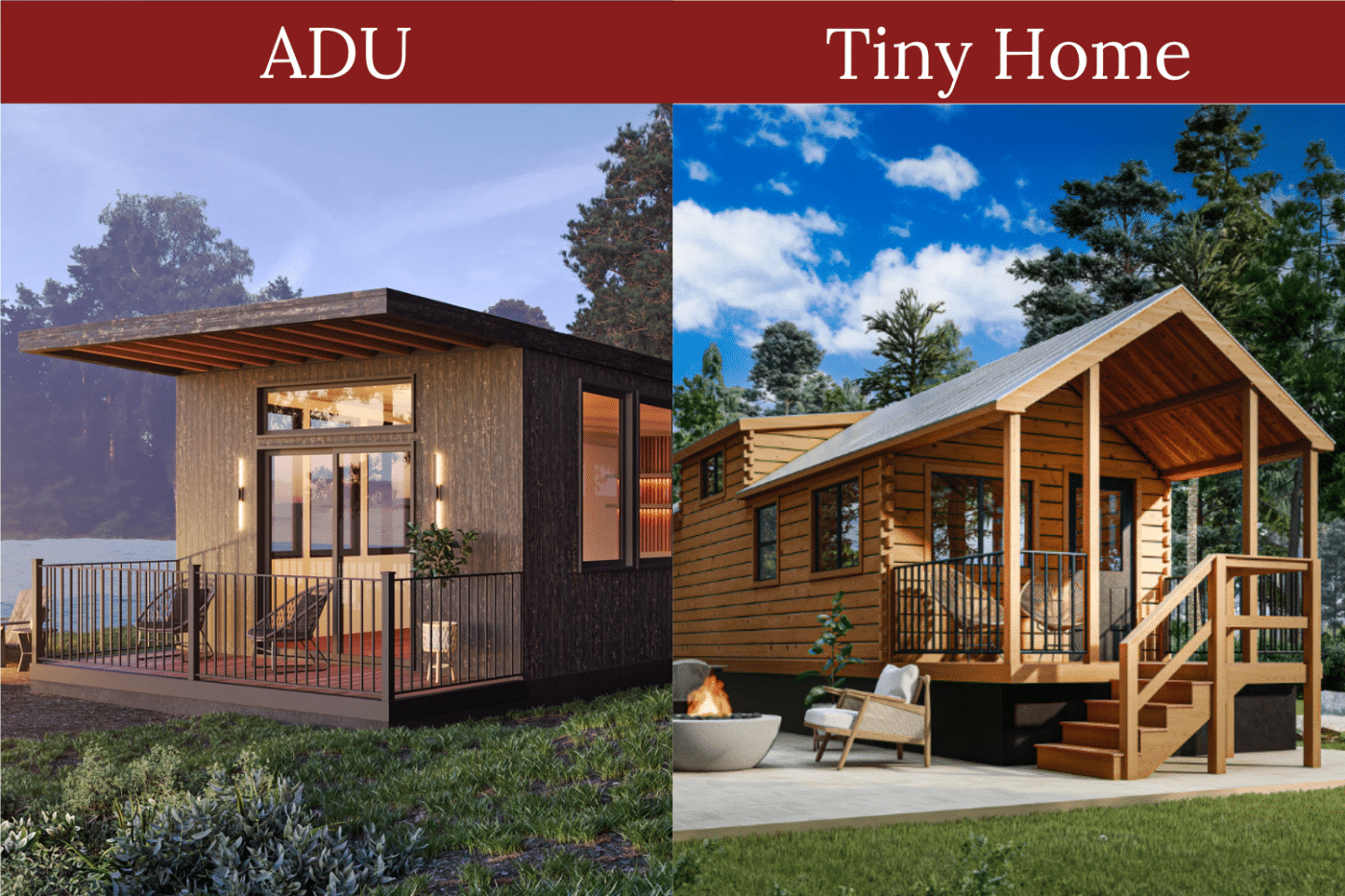
Construction
As we mentioned earlier construction for these building styles is slightly different. ADUs will be built exactly like a home. However, Tiny Homes will be built with components that are often more lightweight to make moving them easier.
Size
Tiny Homes are viewed as dwelling spaces that are 400 square feet and under. On the other hand, ADUs typically have requirements for what is needed for room sizes and total square footage. Yet in some places, you may see that an ADU is smaller than a Tiny Home but that is often a rare occurrence.
Attachment
ADUs may be attached or detached from the home. However, Tiny homes are not built to be attached to a primary dwelling unit. In this way, Tiny Homes gives you more autonomy to move your location wherever you desire whenever you desire.
Zoning and Regulations
Many municipalities are changing their mind about allowing ADUs. However, in most instances, the ADUs that are favored must be built to the regulation of a home. On the other hand, because tiny homes are often not built to the same requirements as ADUS, they often do not fit what the municipality stipulates on what is required for ADU use. However, some states are adopting their use for ADU purposes.
Foundation
When it comes to a foundation a tiny home does not need the same kind of foundation as an ADU. An ADU will need either a crawlspace or a basement foundation. On the other hand, a tiny home can be set on a poured concrete foundation or packed gravel foundation similar to what a shed is put on.
Rental Options
ADUs are designed to be a permanent living structure. Therefore you can rent them out as a full-fledged apartment giving you some great “passive income”. On the other hand Park Model Tiny Homes can not typically be rented out for long-term living but make a great option for short-term rentals. Check out some of the park model homes we have listed for a great weekend getaway.
Cost
ADUs and Tiny Homes are often thought of as having similar price points when it comes to construction. However, Tiny Homes tend to be less expensive because they do not need to have the same kind of permitting or foundations. However, while ADUs are more expensive they tend to be more sought after as it adds value to an existing home.
Legal Terminology
By and Large ADUs and Tiny Homes are very similar until you get down to the legality of it all. Many places will allow you to have some sort of ADU. Yet once you throw out the word Tiny Home the game is over. This is because municipal governments oftentimes have a legal zoning term for ADUs that does not transfer to Tiny Homes. However, take a look at our blog on the top 7 ADU-friendly states, you may be surprised to find out where you can put your Park Model Tiny Home and use it as an ADU with no issue.
Can A Tiny Home Be Used As a Permanent Residence?

Yes. Yet it depends on your state and local zoning laws, as well as where you intend to park your tiny home. For example, many urban areas do not allow Tiny Homes On Wheels (Park Models) within the city limits. However, because tiny homes are built to RV standards some campgrounds will allow you to park your tiny home.
Can ADUs be Used as Permanent Residence?
Yes. The purpose of an ADU is to allow for more affordable housing to be available. In fact, in some states like California, you can even sell your ADU as a separate home altogether.
Can A Tiny Home Be Used As An ADU?

Yes. A Tiny House can be used as an accessory dwelling unit. However, you need to check your local laws to see if there are provisions to allow for that kind of use. Some places may allow you to use your tiny home for a living arrangement for several weeks; while others may say no to the idea of using a Tiny Home as an ADU altogether.
Are Tiny Homes Or ADUs More Cost-Effective For Upfront Cost?

Park Model Tiny Homes are the most cost-effective when it comes to upfront fees. Not only that but because they are smaller, they typically have lower costs when needing to make necessary repairs, or factoring in month-to-month expenses. However, because there are grants for ADUs they more become more affordable than tiny homes in certain areas.
Are Tiny Homes Or ADUs a Better Long-Term Investment?

Knowing if Tiny Homes or ADUs are a better long-term investment is yet to be determined.
What we do know is that on average an ADU will increase the property of your home. A simple in-law suite can increase the home value by 7-10% while a fully completed ADU can increase your home value by up to 30%.
While seeing a 30% increase in the value of your home can be exciting, keep in mind that it may limit the people in interested people in your home. For example, if you were to add an ADU to your home valued at $400,000 adding on an ADU could take your home to a value of $520,000. Depending on the home values in your neighborhood this may not be an issue, on the other hand, it could price your home out of the neighborhood.
On the other hand, the typical Tiny Home can cost you anywhere from $50,000-$100,000+ depending on the fixtures, and how much work you are willing to do yourself. When we partnered with Big Texan RV Ranch, they figured that the payoff time for a park-model tiny home is about 4 years when being used for a vacation rental.
If we were to use Big Texan RV Ranch’s l projections by year 5, you would make about $31,000 a year. In our experience, your park model homes should withstand 20-30 years. This means that based on the Big Texan model you could expect to make $465,000-$775,000.
However, if you are looking to live in a park model it’s not clear if you will make your money back, break even, or make a profit when you go to sell. This is by and large because the real estate market has yet to decide what value Tiny Homes offer to the housing market.
In a nutshell, Park Model Tiny homes are a better investment option if you are looking for short-term rental options. On the other hand, if you are looking for the security of a time-proven investment an ADU may be a better option for you.
What Are The Pros Of A Tiny House Or Park Model Home?

Cost
Tiny homes are far cheaper to build and maintain than a home. This is for two reasons. One they are smaller and thus take less material to build to completion. Second, they are not subject to the same kind of building requirements that stick-built homes are as they fall under RVIA standards.
Portability
Tiny homes can be moved from place to place. And that is one of the biggest advantages of having a tiny home. Keep in mind that depending on the width of your tiny home you may be limited to the time of day and ways in which you can move your tiny home or park model.
Size
Tiny homes are well, tiny. Yet the benefits of living tiny are abundant. Less possessions and less utility cost are the first two that come to mind. Yet something that is often overlooked is that the physical space a tiny home takes up is far less than an ADU or stickbuilt home. You can typically take your park model home and fit it in a 9×30 space, letting you enjoy more of your outdoor property, without the need to buy acres of land.
Lower Maintenance
Tiny homes require maintenance just like any other building. Yet with a smaller building, those expenses tend to be far less. For example, if your water heater goes bad, it will cost you several hundred dollars less than if you had to replace a residential-sized water heater.
Lower Insurance
No one likes paying insurance but it is needed. However, Tiny home insurance is far cheaper than that of a traditional home. Tiny home insurance starts at around $400 a year. Yet a typical home insurance policy is nearly 3 times that amount.
What Are The Cons Of A Tiny Houses?

Zoning
Many municipalities are not quite sure what to do with Park Model tiny homes yet. Many people view these tiny homes as nothing more than a “Fancy RV”. To know if you can live in your Tiny Home full time, you will need to check your local zoning laws.
Resale Value
It isn’t clear if Tiny home values stay the same, go up, or come down as they are still new to the housing market. If you are looking to live in a tiny home and then use it as a rental or short-term vacation home there is really nothing to be worried about. However, if you are looking at this to become a step up on your journey to traditional home ownership we would recommend that you proceed with caution.
Limited Privacy
When you have a tiny space you are limited to finding privacy from others in the space. Now if it is just you living in the space, it won’t be an issue. But add in your spouse’s snoring or a guest that doesn’t understand boundaries, it can become quite difficult to keep your home peaceful.
Furniture Space
Your home needs to be a reflection of who you are as a person. What better way to do that than selecting the furnishings that you love? Now a tiny home won’t completely limit the furniture you can have. Yet, you will need to be conscious of the size you choose, or you will run out of space quickly.
Specific Features
When you have a tiny home some features can be a bit more specific to the building style. Small sinks, smaller appliances, smaller mechanical components, you get the idea. While the products are available, at times they can be a bit more difficult to find.
What Are The Pros Of ADUs?

Increased Home Value
Let’s face it, home renovations tend to be a love-hate relationship. You love the result but the process is a pain. And do you really make any money on your home when it is all said and done? Unlike typical home renovations, ADU will typically give you an increase in your home’s value.
Passive Income
ADUs offer a great way to provide you with some passive income. Since ADUs are regulated just like a home you can rent them out as such. If you want to take it another step further and make it truly passive, employ a property management company to take over the management of your ADU tenant.
Multi-Generational Living
Multi-generational living has many advantages to the development of a family, and ADUs make it so grandma’s house is just a few steps away. On the other hand, you can be close to mom and dad as they age in place without having to worry about their treatment in a retirement community. The only word of caution we have to give you is your kids may have had too many snacks at Grandma and Grandpa’s before coming back for dinner.
More Space
Living in an ADU does offer you some privacy advantages. For example, all of our ADUs are at least 91 square feet larger than our park model tiny homes. Not only that but we also offer two-bedroom options in the A-frame ADU style.
Financial Incentives
In some states like California and Oregon, there are financial grant programs to make ADUs more affordable. Some states will offer you $40,000 to create or update an existing ADU. Before you get too invested in this process, look into the specifications of the ADU usages in your area, as they often have stipulations on how they can specifically be used.
What Are The Cons Of ADUS?

Attached To Your Home
Depending on how your ADU is situated your new ADUs may be attached to your home. This can be quite a bother if they tend to be noisy, or work hours differ from yours. Let’s face it, nothing is worse than having to listen to your neighbor’s 90’s throwbacks when you are trying to get a fussy baby to sleep.
Higher Construction Costs
ADUs need to be built to the specifications of a traditional home. And if you have it built on-site your budget can quickly get tied up as the local market changes for building supplies. However, to combat this issue Zook Cabins builds all of our cabins in our shop letting us control quality, costs, and efficiency.
Stuck WIth Unwanted Tenants
Renter’s rights have good provisions when they need to be applied, but they can often cause issues when the wrong tenant knows how to abuse them. When you use your ADU as a rental it can become a nightmare if the wrong tenant slips through the cracks and ends up sharing the property with you. This is why we see using a property management company as nearly a necessity when renting your ADU to someone else, which ultimately affects your bottom line.
Parking Challenges
You’re having a birthday party for Timmy and everyone keeps calling you because there doesn’t seem to be parking at your house. Sadly this is becoming a reality that people with ADUs are coming to experience. Some states require that the ADU have its off-street parking, while others do not, so check with your municipality.
Conclusion:
Tiny homes and ADUs have areas where they overlap but by and large, are not the same thing. Yes sometimes you can use your TIny home as an ADU but in many circumstances, the local government will not view the buildings as the same. Tiny homes are great options for those who are looking to have a small space and move around with it. They are also good options for short-term rentals if you have the space for them. Some of the biggest issues you will face with Tiny homes are zoning, resale, space limitations, and tiny home-specific features.
On the other ADUs is a great option for people who want to increase the value of their home and offer multi-generational living or consistent “passive income”. These buildings are built to complete residential standards. Some of the biggest issues with ADUs are their proximity to your primary home and the nuisances that can be associated with sharing smaller property space with others.
No matter where you are in your Tiny Park Model Home or ADU journey we want to work alongside you. Contact us at Zook Cabins and we will be happy to help you along the way. If you want to know even more about tiny living or adu regulations check out some of our other blogs!
Disclaimer: The purpose of any financial concepts in this blog is to serve as examples only. You may make more or less money than the figures listed. Nothing in this blog should be used as financial advice. We recommend talking with a financial planner to help you determine the best course of action for your financial goals.
